You know what’s a huge pain where the =sum()don’t shine? Financial reporting, planning and analysis. I often go on and on (and on and on) about startups not getting their financials and operating plans right in their startup pitch decks, so … not gonna lie, I picked Austrian startup Helu.io, which completed a €9.8 million round in July, in the hope that a company that focuses exclusively on FP&A (that’s “financial planning and analysis,” for those who aren’t up to their eyeballs in financial lingo) can show the rest of us how it should be done.
We’re looking for more unique pitch decks to tear down, so if you want to submit your own, here’s how you can do that.
Slides in this deck
When Helu submitted its deck, it did so with a note that revenue and unit economic information was removed.
In a world where I see pre-product, pre-revenue companies spin wild dreams of global market domination, slide 10 comes across as pretty defensive.
Also worth noting (because I’ll be honest, I had to Google it, and I’m all about saving you a Google search or two) what “DACH” stands for, because it appears in the slides below. D is Deutschland — that one is easy. A is for Österreich (Austria) and CH is for … Switzerland. DACH is a somewhat commonly used term for the cluster of countries in Europe that have German as its Sprachraum — in other words, where German is predominantly spoken.
- Cover slide
- “Helu is for CFOs what Personio is for HR” — market opportunity slide
- “The CFO’s pain is Excel” — problem slide
- “Good-bye Excel sheets” — solution slide
- “Our approach is unique and different” — product slide
- “Automated financial reporting: real-time in one step” — value proposition slide
- “Collaborative analysis” – value proposition slide
- “Addressing a 100bn B2B SaaS market globally” — TAM slide
- “Multi-billion market in DACH alone” — SAM slide
- “Specifics of DACH market” — SOM slide
- “Unique position in DACH” — moat/competitive advantage slide
- “Helu automating data aggregation” — product slide
- “Helu’s typical customer” — customer profile slide
- “Top notch international team” — team slide
- “Backed by strong investors and advisors” — investors and advisors slide
- Closing slide
Three things to love
Overall, Helu’s slide deck comes across as a little strange seen through Silicon Valley eyes. Having an English-language slide deck focusing on German-speaking countries, without really saying anything about an English-language expansion plan, is oddly unsettling. There are also some notable things missing from this slide deck — but I’m getting ahead of myself. Let’s take a look at the things that work great, first of all.
Solid value proposition
For founders working in a space that is a little inside baseball, it can be really tempting to over-explain what a product does. The truth is that the investors don’t really care what your product does. Not really. What they care about is that the customers are happy enough to keep coming back and to get that part of the story across, you need to explain what the customer gets out of it. You do that by sharing the benefits, or the value proposition. The Helu team does that well over the course of two slides:
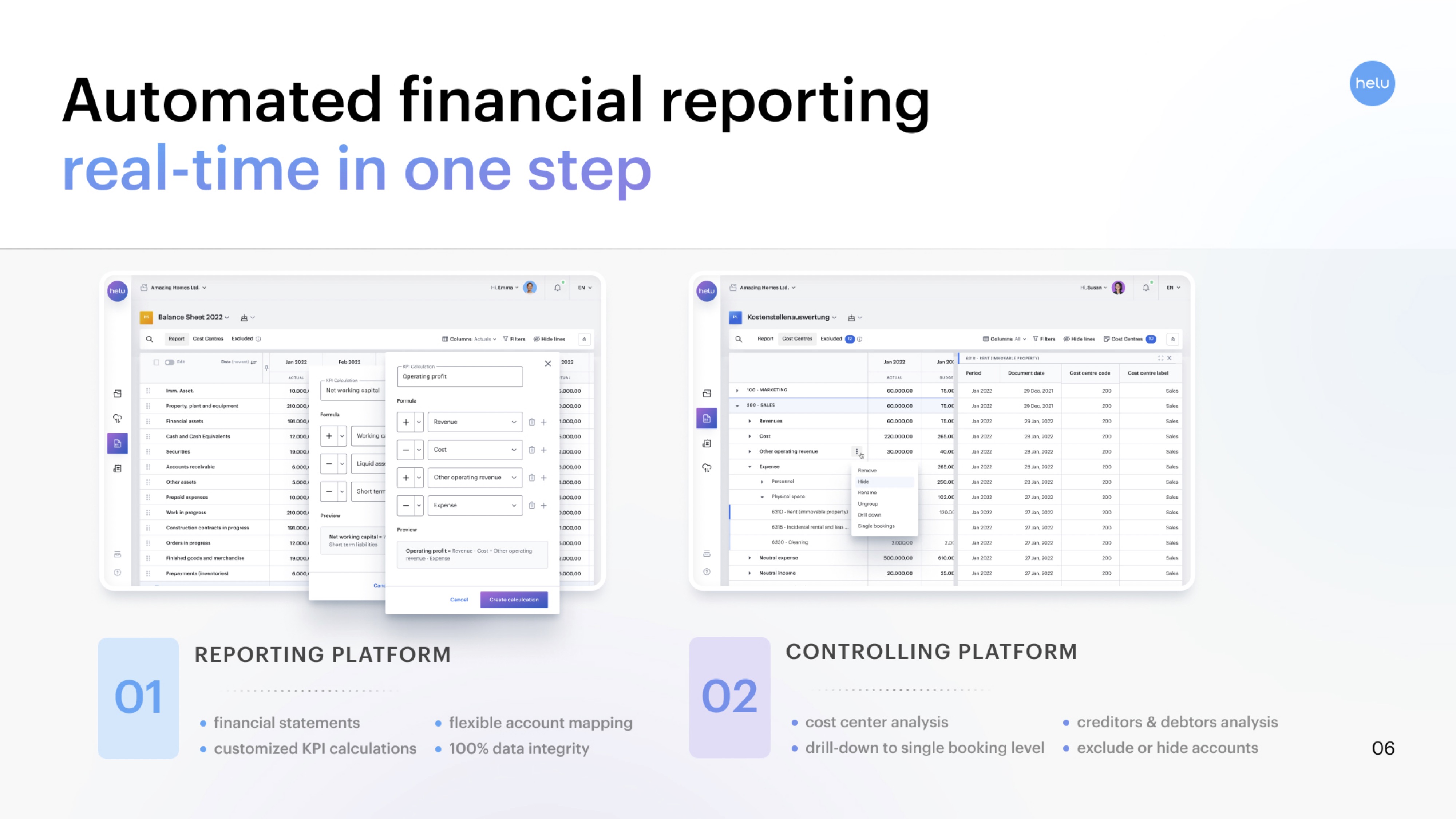
[Slide 6] Part 1 of the value proposition. Image Credits: Helu
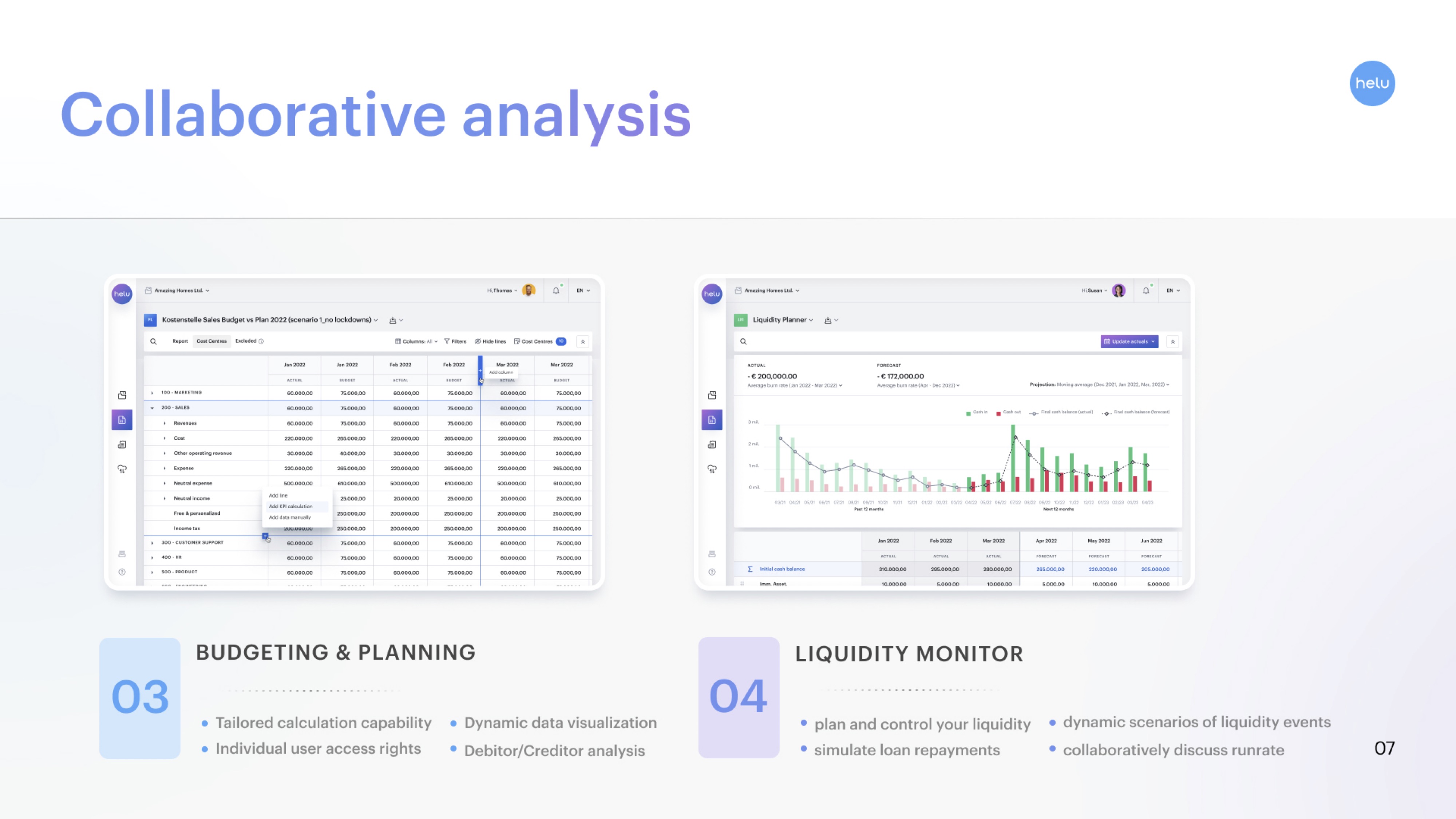
[Slide 7] Part 2 of the value proposition. Image Credits: Helu
Now, these slides aren’t complete slam dunks; I’d have loved more consistency. In Slide 7, the bullets on the left have capital letters and the ones on the rest start in lowercase. The slides flip-flop between using “&” and “and” to tie things together. But overall, they do the trick.
Show me the money. And take my money.
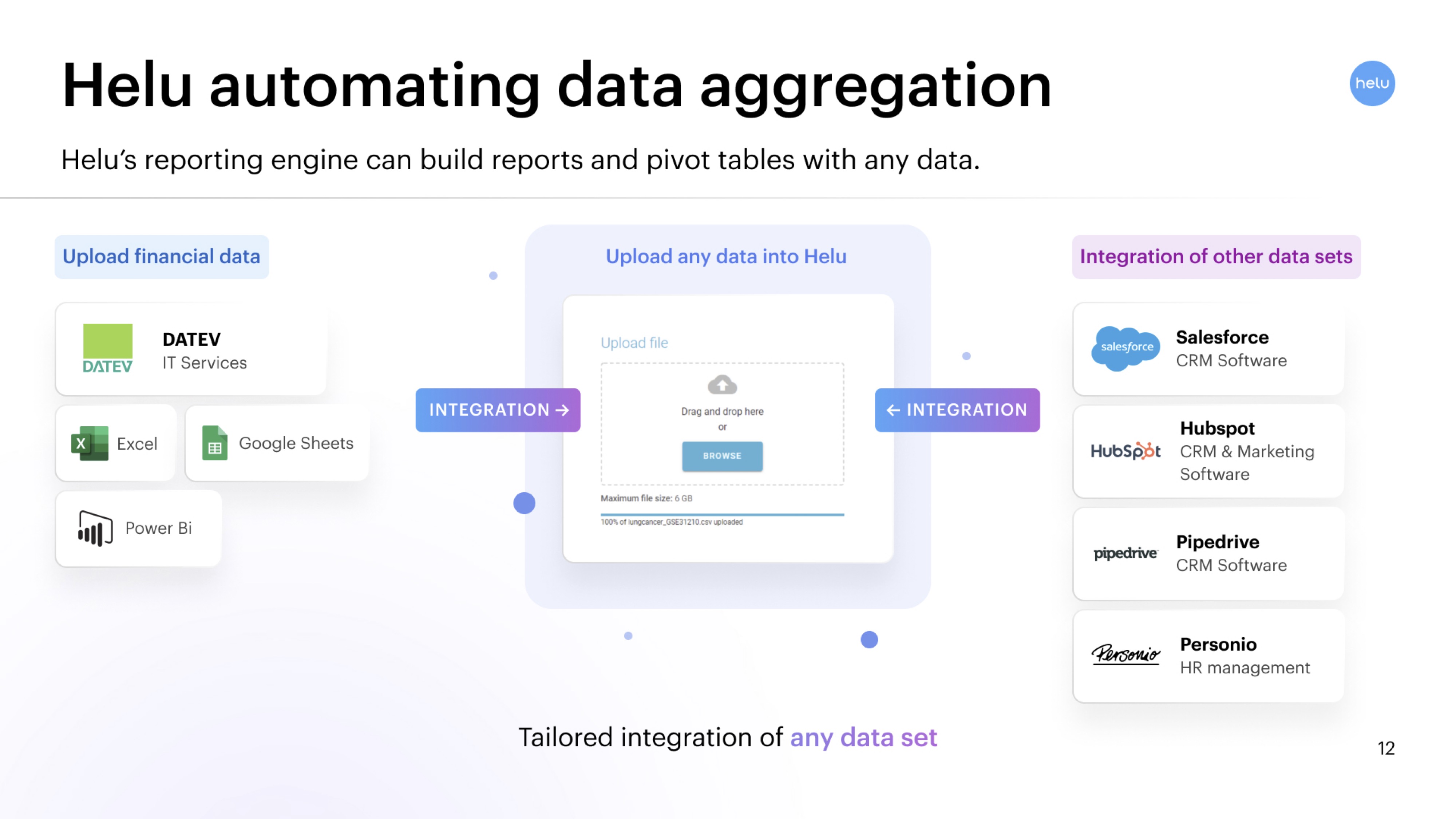
[Slide 12] Take my money; I’ve wanted this product since I started my very first company. Image Credits: Helu
I think this slide is masterful; it shows the power of Helu’s tools in a way that helps a potential investor understand why this is so important. I wouldn’t be at all surprised if the investors asked one or more of their startups to try out Helu’s tools for their financial modeling and reporting; they fall in the center of the bullseye for the product, and if it works as well as it looks like it might, it’s an obvious win. The slide itself is understated and simple, but if I squint my ears, I can hear a founder deliver a voice-over with an example or two showing how powerful this can be.
Excellent moat
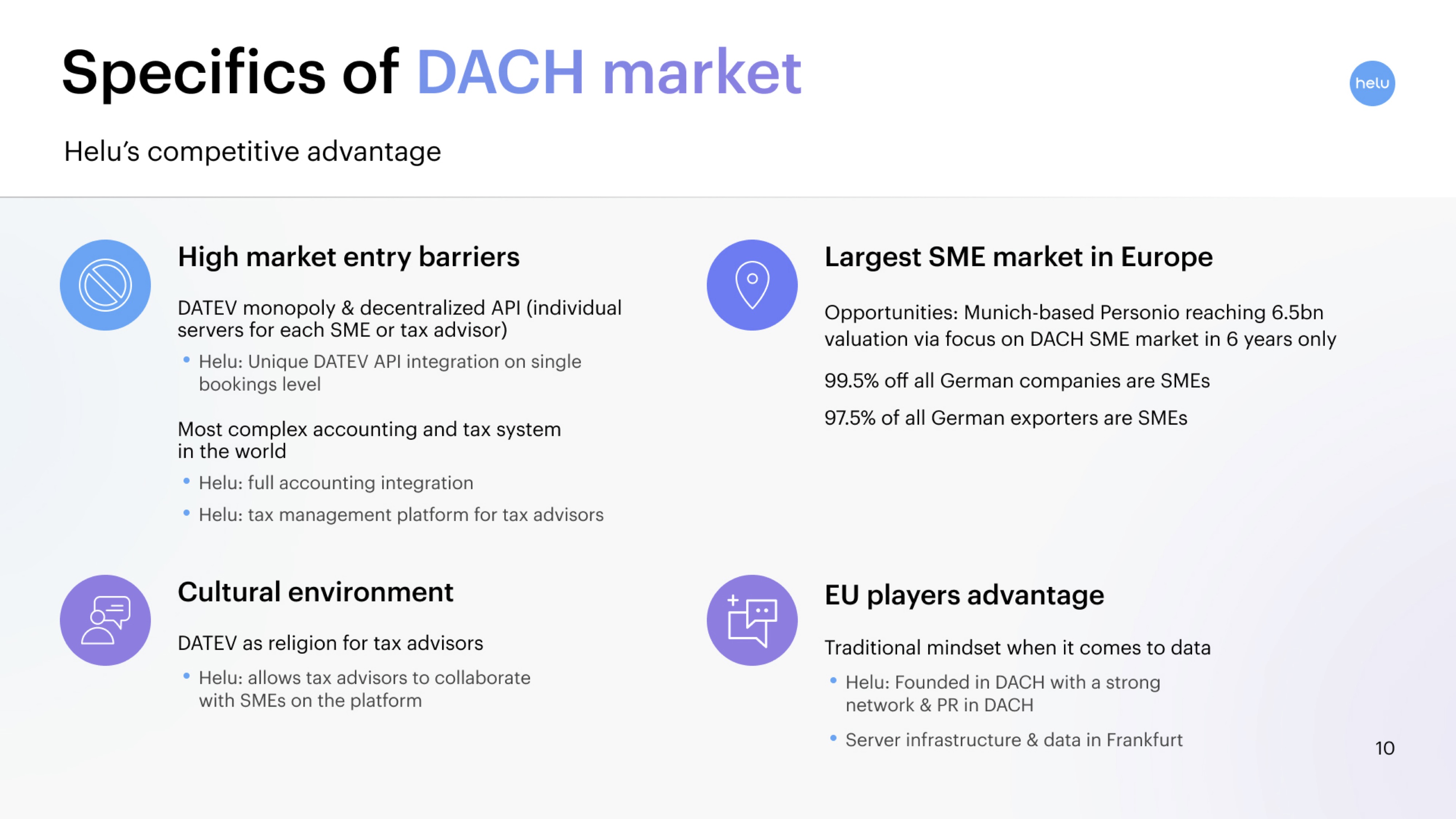
[Slide 10] Once you get a foothold in the DACH market, you’re golden. Image Credits: Helu
What I do love about this slide is that it paints a picture of how, once Helu gets a solid foothold in this market, it will be essentially unbeatable; and I suspect $10 million and a solid product will help it in this. It’s not going to get competition from overseas anytime soon, on account of having “the most complex accounting and tax system in the world.” I’m sure someone from the Internal Revenue Service reads that and will start to feel a little competitive, but I buy that it’s likely a rather unique landscape of rules and regulations.
With an additional twist: The German Mittelstand is a powerful force to be reckoned with. These are thousands of small but efficiently run businesses that are hard to imagine in any other country; in the U.S., small companies tend to get rolled into bigger ones. As the company points out, 99.5% of all companies and 97.5% of all exporters fall into the SME category. That’s a landscape most international SaaS businesses don’t really know what to do with; local and cultural knowledge and building tools that work very well for this specific subset of companies mean that Helu could end up with a formidable moat. The company doesn’t come straight out and say that this is a “winner take all” market, but I think that’s what they are getting at.
In the rest of this teardown, we’ll take a look at three things Helu could have improved or done differently, along with its full pitch deck!
Three things that could be improved
There were a few things I really loved about this deck, but, goodness, there were some serious head-scratchers, too. Basically, I suspect we are running into some cultural differences here, in terms of how companies are built. This pitch deck wouldn’t fly in Silicon Valley. I hasten to add that it didn’t have to, so it’s possible my feedback is way off the mark. Still, let’s take a peek at some of the things that stood out here.
Whoa whoa, whoa. That’s not your market size.
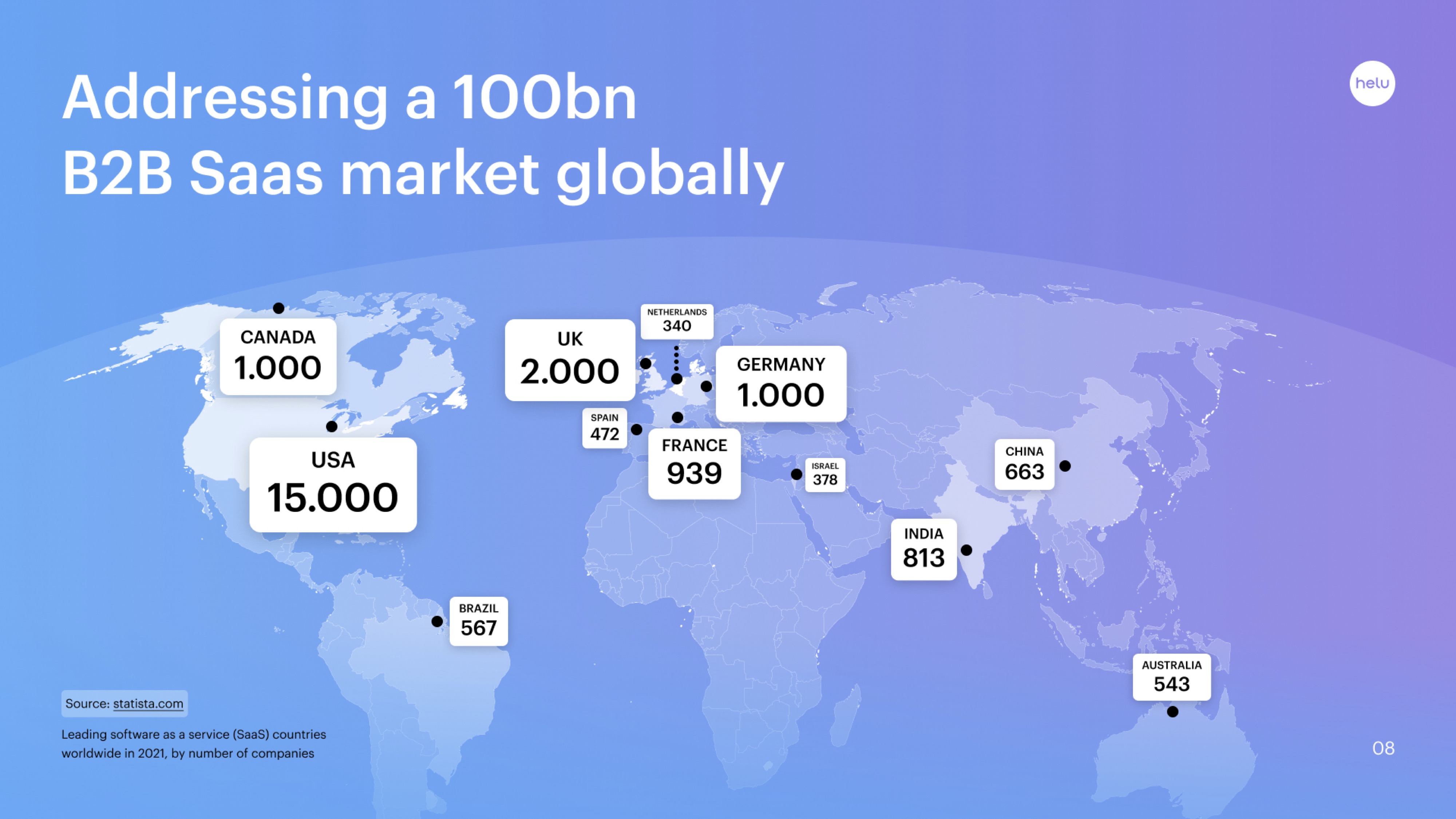
[Slide 8] Hold your horses. That’s not your TAM. Image Credits: Helu
At best, this slide gives an indication of where the biggest homes of SaaS companies are, but the $100 billion number is irrelevant, and I’m really struggling with how the company would defend this slide in its deck: It’s not the TAM. It isn’t even the customer base (because they could also serve a large number of non-SaaS companies).
I would also give the company a medium amount of shit for not putting a Swiss franc, U.S. dollar or euro sign in front of its market size, but it turns out the franc and the euro are within rounding errors of being worth a dollar these days, so the joke is on me. Still, it’s good practice (and using a euro symbol would explain using the full stop as a thousands separator; in Germany, they use a comma as the decimal point, so where we would write $1,123.56, they’d write €1.234,56. It’s details, for sure, but it’s details I’d expect an accounting company to get right, and I think it really harms the company’s credibility in this case.
Where’s your ambition?

[Slide 10] I get that the DACH market is big, but … when are you going farther afield? Image Credits: Helu
I get that Helu is a particularly good fit with the DACH markets, but the total GDP of those three countries is $5 trillion. A fifth of U.S. GDP and only about 1/17th of global GDP. If you’re building a globally focused SaaS company, I’d expect there to be plans of how market expansions are going to take place. Possibly with a timeline.
Look, there’s nothing wrong with building a software startup that tackles a local market — and as Helu points out, Personio, also based in Germany, is focusing just on Europe and is valued at $8.5 billion. The big difference is that Personio is clear about its pan-European ambitions, whereas the Helu team seems to be weirdly shy about how it’s going to tackle the rest of the continent.
Wait, where the franc are your figures?!
As I mentioned in the intro, I got super excited to get a deck from a financial reporting company. If there’s one category of startup that I’d trust to get financial reporting right, it’s a company that does <checks notes> financial reporting and analysis. When I finally made it to the end of the deck and realized that the company has no projections, no metrics, no financial statements, no operating plan and no real traction numbers, I had to walk a couple of laps around the block. Are you kidding me?!
This is a SaaS company, servicing other SaaS companies. It raised nearly $10 million. I know there must be dashboards out the wazoo, and these kinds of companies will be raising money on performance indicators and numbers. If they were working with me as a pitch coach, I’d do some moderately aggressive swearing, give them an F (both the expletive and the grade) and send them back to their room to finish their homework.
Startups, this isn’t good enough. At the very least, you’ll want:
- Customer acquisition cost (CAC).
- Average lifetime value (LTV).
- Churn rate (customers leaving).
- Upchurn (customers promoting themselves to higher pricing tiers).
- Downchurn (customers switching to lower pricing tiers).
- Monthly or annual revenue (MRR/ARR).
- Overall revenue figures (although I recognize that the company removed those).
- An operating plan for the next 18 months or so.
- A financial model and projection for the next three to five years.
- What you’re going to do with the money you’re raising.
Regarding the last point, even Tech EU quoted the CEO on the company’s future plans: “The startup will utilise the new cash infusion to expand its product offering with a budget planning module … to set up a seamless experience throughout the budgeting, controlling and reporting processes” — but there’s nothing in the pitch deck that even hints at why the company is raising money and how it will look different after it has deployed the raised funds.
The full pitch deck
If you want your own pitch deck teardown featured on TC+, here’s more information. Also, check out all our Pitch Deck Teardowns and other pitching advice, all collected in one handy place for you!
